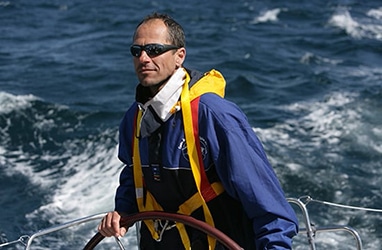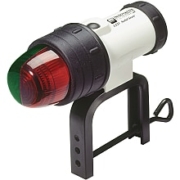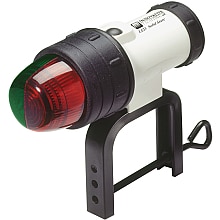Boat and Equipment Emergencies
The character MacGyver in the TV show of the same name would have made a great sailor. Why? Because he could fix anything and a boat is a concoction of a kajillion gadgets busting to rot, rust, short out, unscrew, break, tear, and generally just fall apart. And, Murphy is the guy who makes them do all that as simultaneously as possible, at the most inopportune time so that a seemingly benign failure can turn into an emergency.
The trick then is to prepare and plan for failure by doing lots of preventative maintenance and inspections.
Here is a handy Excel spreadsheet you can use. Customize for your own boat.
Electrical Emergencies
Problems come in two forms: Your DC power supply has been drained or you have a circuit failure.
Loss of Power Supply
It wasn’t too many years ago when sailboats operated perfectly without electricity. And since the laws of the universe have not changed since then, electrical supply failure amounts mostly to the loss of creature comforts. That is, EXCEPT for collision avoidance at night, highlighted by this example in which an acquaintance of ours was nearly run down by a high-speed ferry in the middle of the night in the cold waters of the Solent in the south of England. He had an electrical fire and had to shut down the breakers. ARHHHH!!!
For this reason, it is advisable to have readily available: one each of white, green, and red portable backup navigation lights as well as a flashlight you can reach easily. They are relatively inexpensive and a quick search on Google for portable navigation lights will locate them, or just visit your local chandlery, which is more than likely to have them in stock. Some have suction mounts, some have C-clamps, and some mount on the pulpit railing. Obviously, they should be stowed in an easily accessible place—AND the batteries should be checked often.
It is essential that you understand the “house battery circuit” and the “engine battery circuit” and that they are kept separate as described in Chapter 2. This reduces your chances of an emergency because you are not draining both batteries simultaneously and it is unlikely that you will have both house and engine batteries fail at exactly the same time. Thus, in a pinch, you can swap batteries around (or connect both house and engine circuits together) to get your engine started.
Preventative maintenance includes load testing your batteries every season and testing your alternator voltage output.
Circuit Failure
Circuit failure can be a result of corrosion of connections over time. Corrosion increases resistance at the connection point, which creates heat. The heat can create a failure in the form of fire. Loose connections also create heat or sparking, or they can just fall apart—disconnecting all together. Circuit breakers in the electric panel can also fail over time. Getting electrics or electronic devices wet, especially with salt water is also a major cause of circuit failure. An acquaintance set his Apple TV on fire because salt water dripped from a leaking hatch onto it.
Preventative maintenance includes using an electric joint compound, a corrosion-preventative conductive grease, on all circuit connections you make. A multimeter is also an essential part of the onboard tool kit for diagnosing problems.
Engine Emergencies
If your engine suddenly begins losing power and then stops altogether—you probably have a fuel flow problem. Chapter 3 highlighted the fuel flow system.
Possible causes are:
- Low fuel levels (duh).
- Clogged fuel filters.
- Bad fuel.
- Disconnected fuel lines.
- Air has leaked into the fuel line and the line needs priming.
The engine will also stop for a few other common reasons. A line wrapped around the propeller is a very common one. In this case, the engine will start fine in neutral, but as soon as you put it into gear, it stalls.
A worse scenario is that the water impeller inside the water pump has disintegrated and the engine’s temperature alarm has sounded. This is bad—very bad! Usually, can fix this by replacing the water impeller, assuming you keep a spare on your boat. As soon as the temperature alarm sounds, you need to shut off the engine immediately or you could damage the engine and probably seize it.
Most mechanical emergencies are preventable by regular scheduled professional maintenance. But ensure you have an adequate tool kit on board, including a variety of screwdrivers, pliers, wrenches, hammers, and gloves for working around a hot engine for those times when you need them.
Your anti-Murphy plan regarding engine failure, then, is to become adept at sailing the boat to the dock. When bringing the boat back to the marina, leave the sails in a position where they can be quickly re-hoisted if you have an engine failure.
Rigging Emergencies
Rigging emergencies seldom occur, and are usually caused by a lack of regular inspection. At least quarterly, you should check all the cotter pins in the turnbuckles for your standing rigging stays. Cotter pins prevent turnbuckles from unwinding. Without them, a turnbuckle can unwind in a matter of a few hours of sailing causing a dismasting, which is certainly the very worst scenario beyond sinking for a sailboat. If a stay loses its turnbuckle connection, immediately turn the boat so that the wind load is taken off that stay. Then immediately rig a line to support the mast. A spare halyard can be used.
The points at which the side, fore, and back stays pass through the hull is a very important place to continually check. If they are not properly sealed, water leaks in and rots the chain plates. This will also cause a dismasting.
A dismasting is certainly an emergency. If this happens there will be a lot of lines and cables in the water. You have to clear all these away prior to starting the engine or you will have a bent propeller shaft and no means of propulsion.
Sail Emergencies
Sails may blow out if stressed beyond their limits. This is generally due to mishandling or aging. It is a frequent event in regattas, where sails are challenged to provide greater speed.
Spinnaker sails are often challenging to handle, they get wrapped up in rigging and lines and become difficult to untangle. When this happens in a race, the crew is usually prepared to cope. However, if it happens when cruising and the crew are challenged it may be a problem.
If a mainsail that is furled into the mast gets badly torn and cannot be furled you will probably be forced to return for assistance.
In most sail emergencies, head the vessel into the wind; sails can usually be brought under control. When sails become torn or ripped, stitching and patches can be used for repair. Other than just being old, sails usually tear because they come in contact with something sharp. Regular inspection of any areas that may touch the sail is advisable. EG broken strands in the shroud lines or cotter pins in the spreaders.








